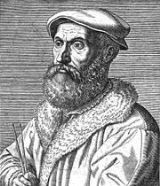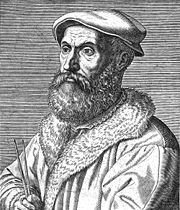
Niccolò Fontana Tartaglia
Encyclopedia

Brescia
Brescia is a city and comune in the region of Lombardy in northern Italy. It is situated at the foot of the Alps, between the Mella and the Naviglio, with a population of around 197,000. It is the second largest city in Lombardy, after the capital, Milan...
– 13 December 1557, Venice
Venice
Venice is a city in northern Italy which is renowned for the beauty of its setting, its architecture and its artworks. It is the capital of the Veneto region...
) was a mathematician
Mathematician
A mathematician is a person whose primary area of study is the field of mathematics. Mathematicians are concerned with quantity, structure, space, and change....
, an engineer
Engineer
An engineer is a professional practitioner of engineering, concerned with applying scientific knowledge, mathematics and ingenuity to develop solutions for technical problems. Engineers design materials, structures, machines and systems while considering the limitations imposed by practicality,...
(designing fortifications), a surveyor (of topography
Topography
Topography is the study of Earth's surface shape and features or those ofplanets, moons, and asteroids...
, seeking the best means of defense or offense) and a bookkeeper from the then-Republic of Venice
Republic of Venice
The Republic of Venice or Venetian Republic was a state originating from the city of Venice in Northeastern Italy. It existed for over a millennium, from the late 7th century until 1797. It was formally known as the Most Serene Republic of Venice and is often referred to as La Serenissima, in...
(now part of Italy
Italy
Italy , officially the Italian Republic languages]] under the European Charter for Regional or Minority Languages. In each of these, Italy's official name is as follows:;;;;;;;;), is a unitary parliamentary republic in South-Central Europe. To the north it borders France, Switzerland, Austria and...
). He published many books, including the first Italian translations of Archimedes
Archimedes
Archimedes of Syracuse was a Greek mathematician, physicist, engineer, inventor, and astronomer. Although few details of his life are known, he is regarded as one of the leading scientists in classical antiquity. Among his advances in physics are the foundations of hydrostatics, statics and an...
and Euclid
Euclid
Euclid , fl. 300 BC, also known as Euclid of Alexandria, was a Greek mathematician, often referred to as the "Father of Geometry". He was active in Alexandria during the reign of Ptolemy I...
, and an acclaimed compilation of mathematics
Mathematics
Mathematics is the study of quantity, space, structure, and change. Mathematicians seek out patterns and formulate new conjectures. Mathematicians resolve the truth or falsity of conjectures by mathematical proofs, which are arguments sufficient to convince other mathematicians of their validity...
. Tartaglia was the first to apply mathematics to the investigation of the paths of cannonballs; his work was later validated by Galileo
Galileo Galilei
Galileo Galilei , was an Italian physicist, mathematician, astronomer, and philosopher who played a major role in the Scientific Revolution. His achievements include improvements to the telescope and consequent astronomical observations and support for Copernicanism...
's studies on falling bodies. He also published a treatise on retrieving sunken ships.
Niccolò Fontana was the son of Michele Fontana, a rider and deliverer. In 1505, Michele was murdered and Niccolo, his two siblings, and his mother were impoverished. Niccolò experienced further tragedy in 1512 when the French invaded Brescia during the War of the League of Cambrai
War of the League of Cambrai
The War of the League of Cambrai, sometimes known as the War of the Holy League and by several other names, was a major conflict in the Italian Wars...
. The militia of Brescia defended their city for seven days. When the French finally broke through, they took their revenge by massacring the inhabitants of Brescia. By the end of battle, over 45,000 residents were killed. During the massacre, a French soldier sliced Niccolò's jaw and palate with a saber. This made it impossible for Niccolò to speak normally, prompting the nickname "Tartaglia" ("stammerer").
There is a story that Tartaglia learned only half the alphabet from a private tutor before funds ran out, and he had to learn the rest for himself. Be that as it may, he was essentially self-taught. He and his contemporaries, working outside the academies, were responsible for the spread of classic works in modern languages among the educated middle class.
His edition of Euclid in 1543, the first translation of the Elements
Euclid's Elements
Euclid's Elements is a mathematical and geometric treatise consisting of 13 books written by the Greek mathematician Euclid in Alexandria c. 300 BC. It is a collection of definitions, postulates , propositions , and mathematical proofs of the propositions...
into any modern European language, was especially significant. For two centuries Euclid had been taught from two Latin translations taken from an Arabic source; these contained errors in Book V, the Eudoxian
Eudoxus of Cnidus
Eudoxus of Cnidus was a Greek astronomer, mathematician, scholar and student of Plato. Since all his own works are lost, our knowledge of him is obtained from secondary sources, such as Aratus's poem on astronomy...
theory of proportion, which rendered it unusable. Tartaglia's edition was based on Zamberti's Latin translation of an uncorrupted Greek text, and rendered Book V correctly. He also wrote the first modern and useful commentary on the theory. Later, the theory was an essential tool for Galileo, just as it had been for Archimedes
Archimedes
Archimedes of Syracuse was a Greek mathematician, physicist, engineer, inventor, and astronomer. Although few details of his life are known, he is regarded as one of the leading scientists in classical antiquity. Among his advances in physics are the foundations of hydrostatics, statics and an...
.
Solution to cubic equations
Tartaglia is perhaps best known today for his conflicts with Gerolamo CardanoGerolamo Cardano
Gerolamo Cardano was an Italian Renaissance mathematician, physician, astrologer and gambler...
. Cardano cajoled Tartaglia into revealing his solution to the cubic equations, by promising not to publish them. Several years later, Cardano happened to see unpublished work by Scipione del Ferro
Scipione del Ferro
Scipione del Ferro was an Italian mathematician who first discovered a method to solve the depressed cubic equation.-Life:Scipione del Ferro was born in Bologna, in northern Italy, to Floriano and Filippa Ferro...
who independently came up with the same solution as Tartaglia. As the unpublished work was dated before Tartaglia's, Cardano decided his promise could be broken and included Tartaglia's solution in his next publication. Even though Cardano credited his discovery, Tartaglia was extremely upset. He responded by publicly insulting Cardano.
Volume of a tetrahedron
Tartaglia is also known for having given an expression (Tartaglia's formula) for the volumeVolume
Volume is the quantity of three-dimensional space enclosed by some closed boundary, for example, the space that a substance or shape occupies or contains....
of a tetrahedron
Tetrahedron
In geometry, a tetrahedron is a polyhedron composed of four triangular faces, three of which meet at each vertex. A regular tetrahedron is one in which the four triangles are regular, or "equilateral", and is one of the Platonic solids...
(incl. any irregular tetrahedra) as the Cayley–Menger determinant of the distance values
Distance
Distance is a numerical description of how far apart objects are. In physics or everyday discussion, distance may refer to a physical length, or an estimation based on other criteria . In mathematics, a distance function or metric is a generalization of the concept of physical distance...
measured pairwise between its four corners:

where d ij is the distance between vertices i and j. This is a generalization of Heron's formula for the area of a triangle
Triangle
A triangle is one of the basic shapes of geometry: a polygon with three corners or vertices and three sides or edges which are line segments. A triangle with vertices A, B, and C is denoted ....
.
Triangle
Tartaglia is known for having devised a method to obtain binomial coefficientBinomial coefficient
In mathematics, binomial coefficients are a family of positive integers that occur as coefficients in the binomial theorem. They are indexed by two nonnegative integers; the binomial coefficient indexed by n and k is usually written \tbinom nk , and it is the coefficient of the x k term in...
s called Tartaglia's Triangle (also called Pascal's Triangle
Pascal's triangle
In mathematics, Pascal's triangle is a triangular array of the binomial coefficients in a triangle. It is named after the French mathematician, Blaise Pascal...
).

